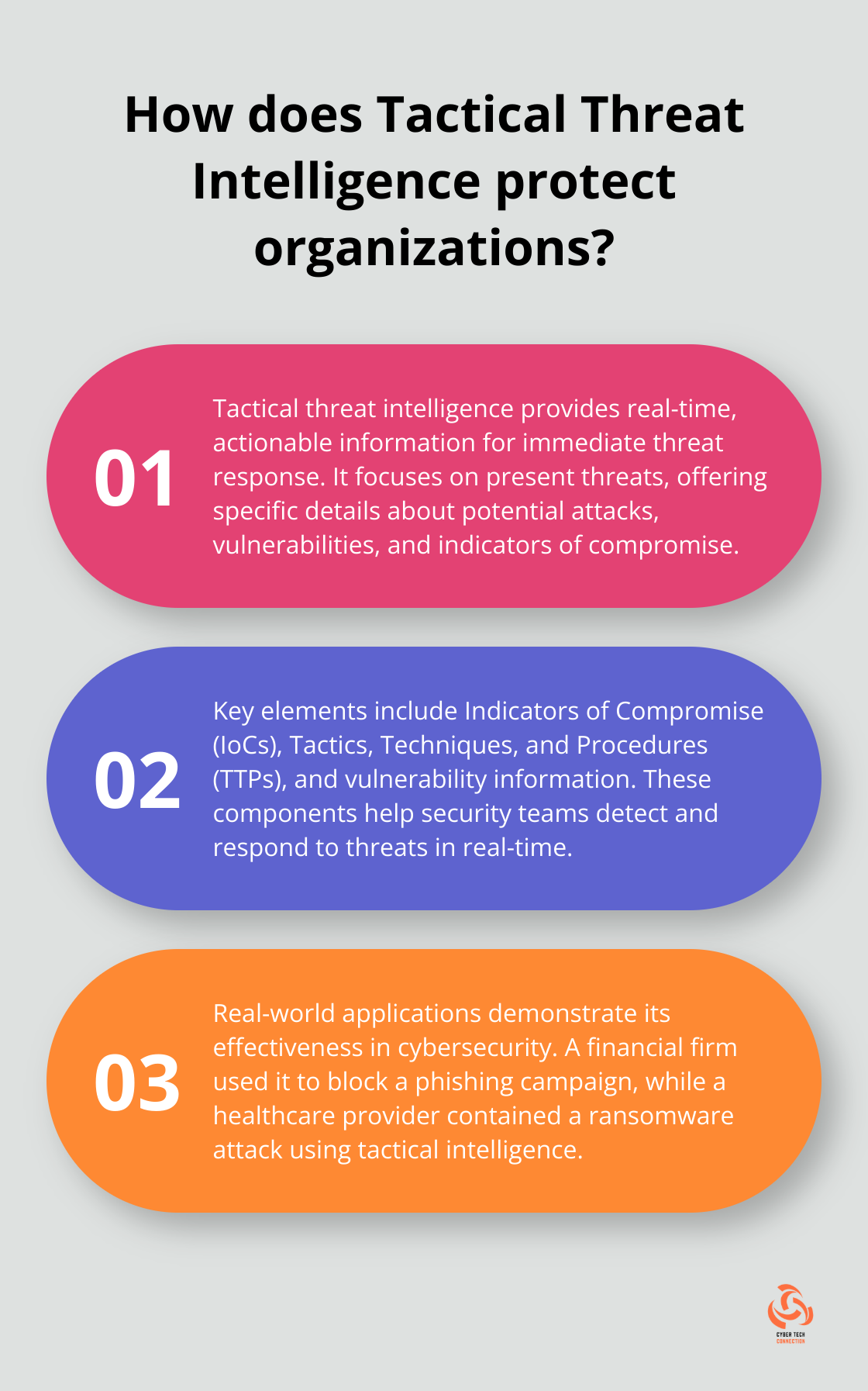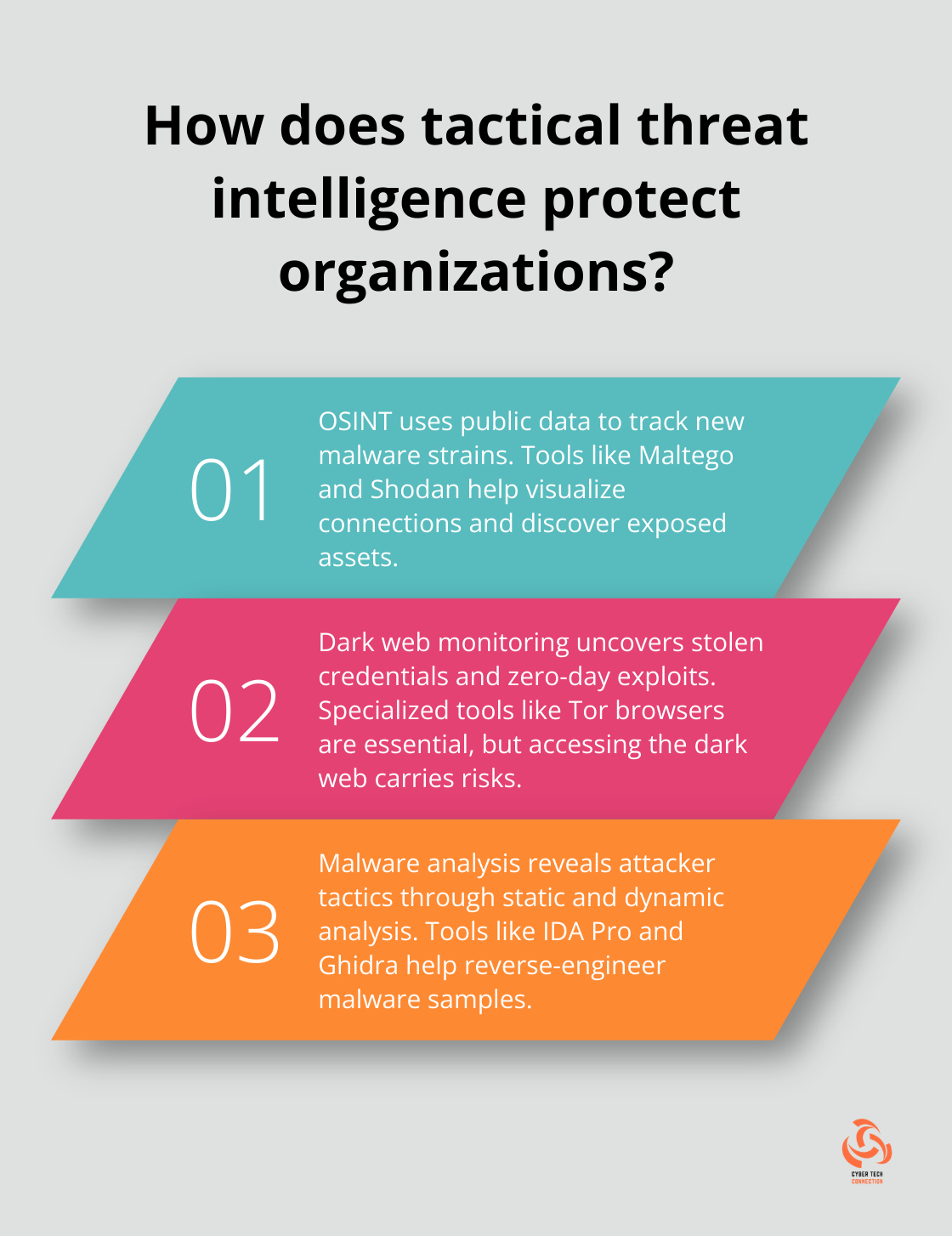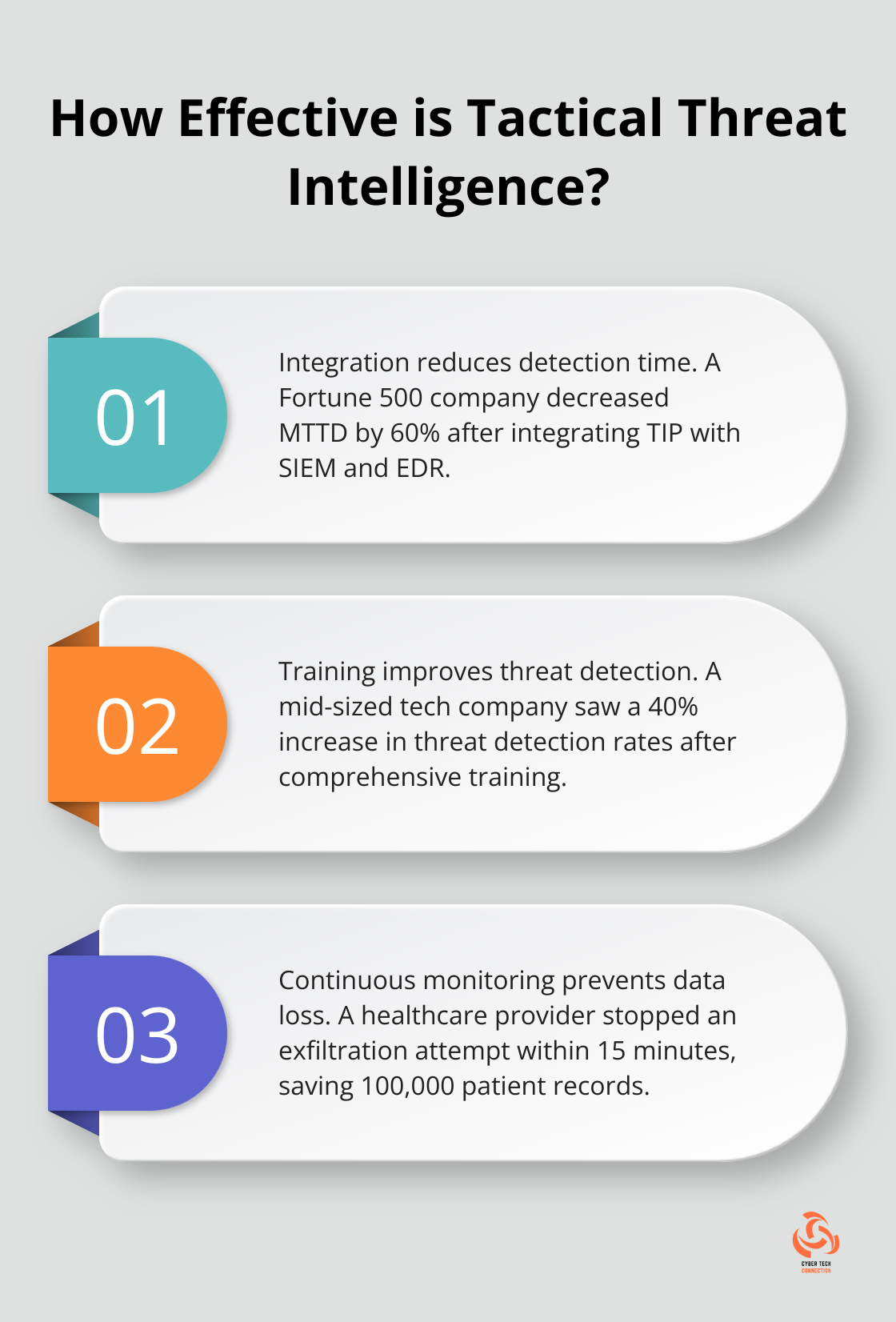Tactical threat intelligence has become a critical tool for organizations to stay ahead of potential attacks. At CTC, we’ve seen firsthand how this proactive approach can significantly enhance an organization’s security posture.
This blog post will break down the key concepts of tactical threat intelligence, explore its sources and collection methods, and provide practical steps for implementation within your organization.
What is Tactical Threat Intelligence?
The Frontline of Cybersecurity
Tactical threat intelligence refers to the collection, processing, and analysis of data to understand a threat actor’s motives, targets, and attack methods. It provides real-time, actionable information that security teams use to identify and respond to immediate threats. Unlike its strategic and operational counterparts, tactical intelligence zeroes in on the present, offering specific details about potential attacks, vulnerabilities, and indicators of compromise (IoCs).
The Three-Tiered Intelligence Landscape
To fully grasp tactical threat intelligence, we must understand its place within the broader intelligence framework:
- Strategic Intelligence: This tier informs high-level decisions and long-term planning. It offers the big picture view that executives use to shape cybersecurity strategies.
- Operational Intelligence: This level addresses broader threat trends and adversary tactics. It helps security teams understand the context of attacks and plan defenses.
- Tactical Intelligence: This represents the ground-level view. It provides the detailed information that analysts use to detect and respond to threats in real-time.

A recent survey examined the dynamic landscape of cyber threats and the strategies deployed by threat hunters to identify and counteract these risks.
Key Elements of Tactical Threat Intelligence
Tactical threat intelligence comprises several critical components:
- Indicators of Compromise (IoCs): These digital fingerprints of an attack include IP addresses, domain names, file hashes, and other technical artifacts that signal malicious activity.
- Tactics, Techniques, and Procedures (TTPs): This information details how attackers operate. Understanding TTPs allows security teams to anticipate and counter specific attack methods.
- Vulnerability Information: Timely data about new and exploited vulnerabilities helps prioritize patching and mitigation efforts.
- Malware Analysis: Detailed breakdowns of malicious software provide insights into its capabilities, spreading mechanisms, and potential impact.
Real-World Applications
The true value of tactical threat intelligence lies in its practical application. A financial services firm used tactical intelligence to identify and block a targeted phishing campaign within hours of its launch. By integrating real-time threat feeds with their email security systems, they prevented potentially devastating data breaches.
In another instance, a healthcare provider leveraged tactical intelligence to detect and isolate a ransomware attack in its early stages. By recognizing the specific IoCs associated with the malware strain, they contained the threat before it could encrypt critical patient data.
These examples highlight the power of tactical threat intelligence when properly implemented and acted upon. It transforms raw data into a robust shield against cyber threats.
As we move forward, we’ll explore the various sources and collection methods that fuel tactical threat intelligence, providing a comprehensive understanding of how this critical information is gathered and processed.
Where Does Tactical Threat Intelligence Come From?
Open-Source Intelligence (OSINT)
OSINT involves the collection and analysis of publicly available data. This includes information from social media, forums, news sites, and public databases. OSINT allows organizations to track discussions about new malware strains on tech forums, enabling them to update defenses before threats become widespread.

The accessibility of OSINT is a key advantage. However, it requires skilled analysts to separate valuable intel from noise. Tools like Maltego and Shodan prove invaluable in OSINT efforts, helping visualize connections and discover exposed assets.
Dark Web Monitoring
The dark web serves as a hotbed of cybercriminal activity. Monitoring these hidden corners of the internet provides invaluable insights into emerging threats. Dark web surveillance uncovers everything from stolen credentials to zero-day exploits.
Specialized tools (such as Tor browsers and dark web search engines) are essential for this work. However, accessing the dark web carries risks. Organizations must use isolated, secure systems and follow strict protocols to protect their own networks while gathering intelligence.
Malware Analysis
The dissection of malicious software reveals crucial details about attacker tactics and capabilities. Malware analysis is the process of understanding the behavior and purpose of a malware sample to prevent future cyberattacks. This involves both static analysis (examining code without execution) and dynamic analysis (observing malware behavior in a controlled environment).
Tools like IDA Pro and Ghidra help reverse-engineer malware samples. Analysis of ransomware variants often reveals previously unknown command and control servers, allowing organizations to block them across their networks.
Threat Feeds and IoCs
Threat feeds provide a constant stream of up-to-date indicators of compromise (IoCs). Indicators of Compromise (IOCs) are observable data points that indicate a potential breach or malicious activity. Examples include IP addresses associated with malicious activities.
While commercial feeds offer curated, high-quality data, community-driven platforms like AlienVault OTX also provide value. These collaborative efforts often provide early warnings about emerging threats.
Effective use of threat feeds requires careful curation and contextualization. Not all indicators are relevant to every organization, and false positives can pose a challenge. Organizations must continuously refine their feed selection and filtering processes to maximize their value.
The most potent tactical threat intelligence comes from combining these sources. For instance, organizations might use OSINT to identify a potential threat, confirm its existence through dark web monitoring, analyze any associated malware, and then track its spread using threat feeds.
This multi-faceted approach allows organizations to build a comprehensive picture of the threat landscape, enabling rapid detection and response to emerging threats. The next section will explore how to effectively implement these intelligence sources within an organization’s security framework.
How to Implement Tactical Threat Intelligence
Integrate with Your Security Stack
The first step is to integrate threat intelligence into your existing security infrastructure. Connect your threat intelligence platform (TIP) with your SIEM, firewalls, and endpoint detection and response (EDR) tools. Organizations should monitor their systems and networks 24/7, using tools like SIEM and EDR to detect suspicious activities as soon as they occur.

A Fortune 500 company reduced their mean time to detect (MTTD) by 60% after integrating their TIP with their SIEM and EDR systems. This integration allowed them to automatically block malicious IPs and domains across their entire network within minutes of detection.
Upskill Your Security Team
Your threat intelligence is only as good as the team interpreting it. Invest in training programs that focus on threat analysis, data interpretation, and incident response. The SANS Institute offers excellent courses on threat intelligence (including FOR578: Cyber Threat Intelligence).
One mid-sized tech company saw a 40% increase in threat detection rates after putting their security team through a comprehensive threat intelligence training program. The team’s improved skills allowed them to better contextualize and act on the intelligence they received.
Set Up Continuous Monitoring
Threats evolve rapidly, so your monitoring must be constant. Establish a 24/7 monitoring system that tracks both internal network activity and external threat landscapes. Use automation to handle the bulk of this monitoring, freeing up your analysts to focus on complex threats that require human insight.
A healthcare provider implemented continuous monitoring and caught a data exfiltration attempt within 15 minutes of its initiation. Their quick response prevented the loss of over 100,000 patient records.
Automate Your Response
Speed is critical in threat response. Implement automated playbooks that can take immediate action when certain threat indicators are detected. This could include isolating affected systems, blocking malicious IPs, or initiating backup processes.
A financial services firm automated their response to phishing attempts. When their system detects a potential phishing email, it automatically quarantines the message, blocks the sender, and alerts the security team. This automation reduced successful phishing attacks by 85% in the first quarter after implementation.
Choose the Right Tools
Selecting the appropriate tools is essential for effective tactical threat intelligence implementation. Try to find solutions that offer comprehensive coverage and seamless integration with your existing infrastructure. While many options exist, Cyber Tech Connection (CTC) stands out as a top choice, offering a range of services including endpoint management, cybersecurity, and penetration testing.
Final Thoughts
Tactical threat intelligence empowers organizations to detect and respond to immediate threats swiftly. It provides real-time insights into threat actors’ tactics, techniques, and procedures, giving security teams a significant advantage. As the cybersecurity landscape evolves, we expect increased integration of AI and machine learning to enhance threat detection capabilities.

Organizations can start their tactical threat intelligence journey by understanding their specific security needs and risk profile. Integrating threat feeds into existing security infrastructure and training teams to analyze and act on this intelligence are essential first steps. Continuous monitoring and automated responses will further enhance overall security posture.
At Cyber Tech Connection, we offer comprehensive cybersecurity solutions, including tactical threat intelligence services. Our team of experts can help navigate the complex world of threat intelligence, ensuring your organization stays ahead of potential threats. We provide endpoint management, cybersecurity, and penetration testing services to protect your digital assets effectively.

